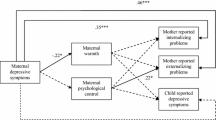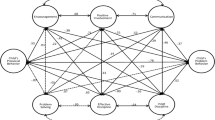Abstract
Observational and self-report data were obtained in the homes of 33 mother-child dyads. These volunteer, normal subjects were monitored with respect to their affectionate and aversive interactions, and the mothers were asked to provide three categories of self-report data. Mothers made observational judgments of their children, their own feelings of depression, and the valences of their interactions with adults. Multiple regression analyses were then employed to predict the mothers' child care behaviors, which were composed of observed mother responses and mother observational judgments. In addition, conditional probability analyses were conducted to examine the directionality of correlations between observed mother-child interchanges. Results showed child behavior to be the best single predictor of how the mothers responded to their children, followed by maternal depression and mother coercive interactions with adults. Child behavior was shown to be a significant antecedent “cue” for the maternal responses. However, the findings also showed that mother observational judgments about their children had little to do with how the children behaved. Rather, the maternal judgments were best predicted by mother depression, mother coercive interchanges with adults, and the mothers' observed aversive responses to their children. Results were interpreted within a systems framework in which maternal care is viewed as a response that is “triangulated” by adult-and child-produced stimuli.
Similar content being viewed by others
References
Ainsworth, M. D. S., Blehar, M., Waters, E., & Wall, S. (1978).Patterns of attachment. Hillsdale, New Jersey: Erlbaum.
Beck, A. (1970).Depression: Causes and treatment. Philadelphia: University of Pennsylvania Press.
Belsky, J. (1981). Early human experience: A family perspective.Developmental Psychology, 17, 3–23.
Clarke-Stewart, K. (1973). Interactions between mothers and their young children: Characteristics and consequences.Monographs of the Society for Research in Child Development,38(6–7, Serial No. 153).
Cochran, M., & Brassard, J. (1979). Child development and personal social networks.Child Development, 50, 601–616.
Crockenberg, S. (1981). Infant irritability, mother responsiveness and social support influences on the security of infant-mother attachment.Child Development, 52, 857–865.
Dumas, J., & Wahler, R. (1983). Predictors of treatment outcome in parent training: Mother insularity and socioeconomic disadvantage.Behavioral Assessment, 5, 301–313.
Dunn, E., Barker, M., & Wahler R. (1981).Standardized observation codes: Revised version. Unpublished training manual, University of Tennessee, Child Behavior Institute, Knoxville.
Forehand, R., King, H., Peed, S., & Yoder, P. (1975). Mother-child interactions: Comparison of a non-compliant clinic group and a non-clinic group.Behaviour Research and Therapy, 13, 79–84.
Griest, D., Wells, K., & Forehand, R. (1979). An examination of predictors of maternal perception of maladjustment in clinic-referred children.Journal of Abnormal Psychology, 88, 277–281.
Johnson, D., & Heather, B. (1974). The sensitivity of the BDI to changes of symptomatology.British Journal of Psychiatry, 125, 183–184.
Kovacs, M., & Beck, A. (1978). Maladaptive cognitive structure in depression.American Journal of Psychiatry, 135, 525–533.
Lamb, M., & Easterbrook, M. (1980). Individual differences in parental sensitivity: Some thoughts about origins, components and consequences. In M. Lamb & L. Sherrod (Eds.),Infant social cognition: Empirical and theoretical considerations (pp. 302–360). Hillsdale, New Jersey: Erlbaum.
Lewis, M., & Goldberg, S. (1969). Perceptual-cognitive development in infancy: A generalized expectancy model as a function of the mother-infant interaction.Merrill-Palmer Quarterly, 15, 81–100.
Parke, R. D., & Collmer, C. W. (1975). Child abuse: An interdisciplinary analysis. In E. M. Hetherington (Ed.),Review of child development research (Vol. 5, pp. 127–160). Chicago: University of Chicago Press.
Patterson, G. R. (1976). The aggressive child: Victim and architect of a coercive system. In E. Mash, L. Hamerlynck, & L. Handy (Eds.),Behavior modification and families: Vol. 1. Theory and research (pp. 109–142). New York: Brunner/Mazel.
Patterson, G. R. (1982).A social learning approach: Coercive family processes. Eugene, Oregon: Castalia.
SAS Institute, Inc. (1979).SES Users Guide (2nd ed.). New York: Author.
Twardosz, S., Schwartz, S., Fox, J., & Cunningham, J. L. (1979). Development and evaluation of a system to measure affectionate behavior.Behavioral Assessment, 1, 117–190.
Wahler, R. G. (1980). The insular mother: Her problems in parent-child treatment.Journal of Applied Behavior Analysis, 13, 207–219.
Wahler, R. G., & Hann, D. M. (in press). A behavioral systems perspective in childhood psychopathology: Expanding the three term operant contingency. In N. Krasnegor (Ed.),Child health behavior. New York: John Wiley and Sons.
Wahler, R. G., House, A. E., & Stambaugh, E. (1976).Ecological assessment of child problem behavior. New York: Pergamon Press.
Wahler, R. G., Leske, G., & Rogers, E. S. (1978). The insular family: A deviance support system for oppositonal children. In L. Hamerlynck (Ed.),Behavioral systems for the developmentally disabled: Vol. 1. School and family environemnts (pp. 102–127). New York: Brunner/Mazel.
Waters, E., Vaughn, B., & Egeland, B. (1980). Individual differences in infant-mother attachment relationships at age one: Antecedents in neonatal behavior in an urban, economically disadvantaged sample.Child Development, 51, 208–216.
Author information
Authors and Affiliations
Rights and permissions
About this article
Cite this article
Panaccione, V.F., Wahler, R.G. Child behavior, maternal depression, and social coercion as factors in the quality of child care. J Abnorm Child Psychol 14, 263–278 (1986). https://doi.org/10.1007/BF00915445
Revised:
Issue Date:
DOI: https://doi.org/10.1007/BF00915445




